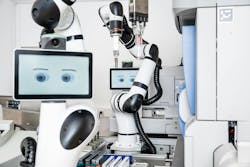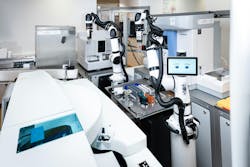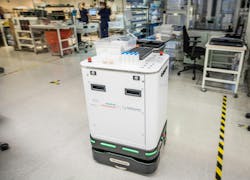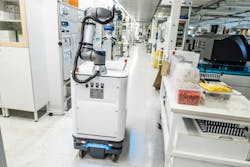Dark Labs: Illuminating the future of fully automated diagnostic laboratories
In recent years, advancements in technology and workflow automation have been revolutionizing the landscape of medical diagnostics, giving rise to the concept of "Dark Labs." The potential of fully automated labs, sometimes referred to as "Dark Labs," represents a novel, and perhaps inevitable, way to address the increasing pressure and decreasing labor force faced by diagnostic laboratories. These state-of-the-art facilities are designed to function without regular human intervention, harnessing the power of robotics, artificial intelligence (AI), and advanced data analytics. By mitigating the current challenge of staff shortages while also potentially addressing human errors like mislabeling, Dark Labs have the potential to revolutionize diagnostic laboratories and significantly enhance the accuracy, efficiency, and speed of medical testing. This article delves into the existing roles within traditional diagnostic laboratories and explores the disruptive automation technology needed to replace and/or augment these roles to usher in a new era of efficiency and accuracy in an age of workforce scarcity.
Addressing staff shortages
One of the most pressing issues in diagnostic laboratories worldwide is the shortage of skilled medical technologists. The healthcare industry has been grappling with this challenge for years, leading to delays in test results; increased workloads on existing staff; and compromised accuracy due to fatigue, burnout, and turnover. Dark Labs offer a promising solution by reducing the reliance on human personnel.
In Dark Labs, robots and automation systems take on the role of preparing and processing samples, managing consumables, and even analyzing results. This not only speeds up the testing process but also minimizes the need for a large number of skilled technicians. The available staff can focus on more specialized tasks that require human expertise, such as interpreting complex results and making critical decisions. By alleviating the burden on human workers, Dark Labs ensure that diagnostic procedures are carried out efficiently and accurately.
Eliminating human errors
Human errors, such as mislabeling samples, transcription mistakes, and calculation errors have been a recurring challenge in traditional diagnostic laboratories. These errors not only compromise patient safety but also lead to retesting, delays, and increased healthcare costs. Dark Labs can substantially reduce the risk of human errors by implementing stringent automation protocols. Also, the presence of humans in the lab increases the risk of workplace and sample contamination especially as labs bring in more molecular testing modalities.
Samples in Dark Labs can be processed through automated systems that are designed to handle a wide variety of tests and tubes. With the integration of barcode and RFID technologies, samples are identified and tracked from the moment they enter the lab until the final results are generated. With modern, fully automated solutions, the whole workflow from sample arrival, centrifugation, decapping, testing, and disposal can be managed by intelligent total laboratory systems.
Enhancing efficiency and speed
Traditional diagnostic labs often struggle with lengthy turnaround times for test results, which can lead to delays in treatment and patient management. Dark Labs excel in efficiency and speed, addressing these concerns head-on. Automated systems can more easily process a high volume of samples simultaneously, reducing the time required for testing. Moreover, AI and auto-verification algorithms can quickly analyze data and generate reports, further expediting the diagnostic process.
In semi-Dark Labs, which represent a hybrid approach, some tasks are automated while others involve human oversight. This allows for greater flexibility, as certain complex or novel cases may still benefit from human intervention. The efficiency of Dark Labs can also extend to remote areas where access to specialized diagnostic services is limited. By enabling sample collection centers to connect with fully automated labs, patients in remote locations can receive timely and accurate results without the need for extensive travel.
Data-driven insights and predictive analytics
Dark Labs are not only about automation; they also harness the power of data analytics to provide valuable insights. The vast amount of data generated during the diagnostic process can be used to identify trends, patterns, and correlations that might otherwise go unnoticed. With the help of AI algorithms, Dark Labs could predict disease outbreaks, identify high-risk populations, and contribute to epidemiological research.
Additionally, predictive analytics can aid in optimizing lab resources. By analyzing historical data on testing patterns and seasonal variations, Dark Labs can proactively allocate resources to ensure efficient operations during peak demand periods. This level of foresight is crucial for maintaining a smooth workflow and minimizing bottlenecks. In addition to patient-centric metrics, the predictive analytics can monitor the operation of instruments, automation scheduling, routine maintenance, and service requests if process abnormalities are detected.
Challenges and considerations
While the potential benefits of Dark Labs are vast, their implementation is not without challenges. The initial setup cost of fully automated systems requires up front investments in vessel moving, robotics, AI technology, and infrastructure. These costs may occur before the reduction in staffing costs due to a hybrid phase while laboratories transition between the two operating models. Moreover, processes such as inventory replenishment, routine maintenance, sample loading and others do not currently have standardized, readily available solutions. There is also a need for specialized training for the personnel overseeing the automated processes and managing technical issues.
The transition to Dark Labs might lead to concerns about job displacement for laboratory technicians. However, Dark Labs enable higher throughput so labs can be more productive processing more samples with the same number of staff. In addition, existing staff are freed up to perform more specialized roles or carry out other testing modalities. Technicians could be upskilled to manage the additional types of technology used in their new, more-automated environment.
Conclusion
Dark Labs represent a potential transformative shift in the diagnostic laboratory landscape. By harnessing the power of automation, robotics, and AI, these labs offer a solution to the persistent challenges of staff shortages and human errors. The benefits extend beyond increased efficiency and accuracy; they encompass enhanced speed, data-driven insights, and predictive analytics. As technology continues to evolve, Dark Labs could become an integral part of the healthcare infrastructure. Through careful implementation and continuous refinement, this technology could revolutionize the way medical tests are conducted and diagnoses are made.
About the Author

Mike Heydlauf
is a Senior Key Expert at the Center for Innovations in Diagnostics at Siemens Healthineers. He has been working in laboratory automation and informatics for over 18 years and is a member of IFCCs Committee on Mobile Health and Bioengineering in Laboratory Medicine and an advisor on CLSI’s Expert Panel on Automation and Informatics (AUTO).

Mark Edwards, PhD CEng FIET
is a Principal Key Expert at Siemens Healthineers specializing in mechatronics, automation, and workflow solutions in Laboratory Diagnostics. Mark, a Fellow of the Institute of Engineering and Technology, has spent over 30 years designing and implementing the latest technologies to enable better outcomes for patients and the clinicians that care for them.



